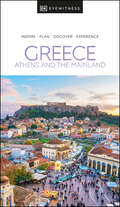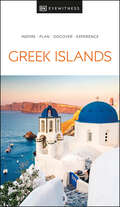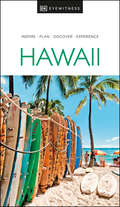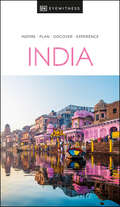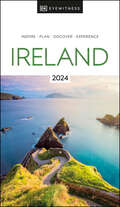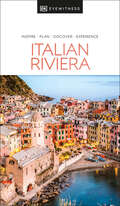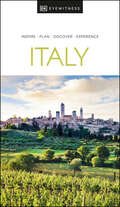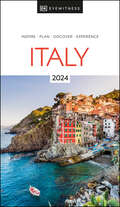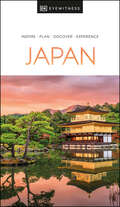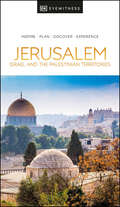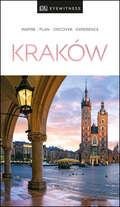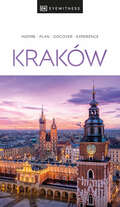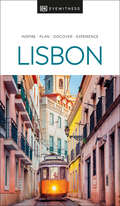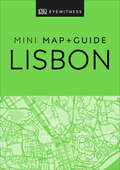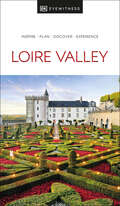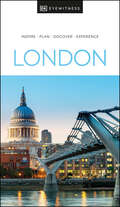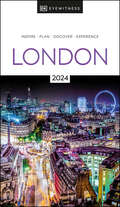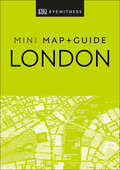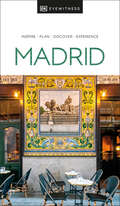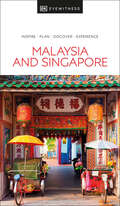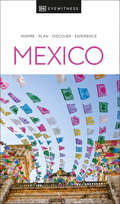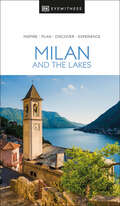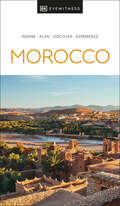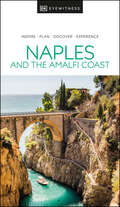- Table View
- List View
DK Eyewitness Greece: Athens and the Mainland (Travel Guide)
by DK EyewitnessWorld-class museums and archaeological sites may be the first things that come to mind when you think of Greece, but the country is home to both old and new. Take Europe&’s oldest city, for example: Athens has a youthful vibe and buzzing nightlife, where upmarket restaurants stand alongside traditional grill eateries and old-school ouzeris jostle with the trendy cocktail bars of up-and-coming urban neighborhoods. Meanwhile Thessaloniki, Greece&’s second city, seduces visitors with its array of Byzantine churches and vibrant contemporary art scene.But it&’s not all about the cities. Kissed by three seas and stretching from the barren peaks of the northern Pindos to the sunny vineyards of Attica and the Peloponnese, the rural landscapes of mainland Greece are stunningly diverse. Outdoor adventurers can trek the dramatic Víkos and Loúsios gorges and climb the craggy peaks of Mount Olympos. Whether you want to watch the sun sink behind the marble columns of the Parthenon in Athens, visit iconic archaeological sites such as Delphi and Olympia, or simply soak up the sun on the sandy beaches of Halkidikí, your DK Eyewitness travel guide makes sure you experience all that mainland Greece has to offer. Our newly updated guide brings Athens and the mainland to life, transporting you there like no other travel guide does with expert-led insights, trusted travel advice, detailed breakdowns of all the must-see sights, photographs on practically every page, and our hand-drawn illustrations which place you inside the region's iconic buildings and neighborhoods. We&’ve also worked hard to make sure our information is as up-to-date as possible following the COVID-19 outbreak. DK Eyewitness Greece: Athens and the Mainland is your ticket to the trip of a lifetime. Inside DK Eyewitness Greece: Athens and the Mainland you will find: - A fully-illustrated top experiences guide: our expert pick of Athens and the mainland&’s must-sees and hidden gems- Accessible itineraries to make the most out of each and every day- Expert advice: honest recommendations for getting around safely, when to visit each sight, what to do before you visit, and how to save time and money- Color-coded chapters to every part of mainland Greece, from Athens to the Peloponnese - Practical tips: the best places to eat, drink, shop and stay in Washington DC- A pull-out map to help you navigate Athens easily and confidently - Covers: Central Athens North, Central Athens South, Around Athens, The Peloponnese, Central, and Western Greece, and Northern GreecePlanning on touring the Greek Islands? Don&’t forget to check out DK Eyewitness Greek Islands to make the most out of your trip and achieve the adventure of a lifetime. If you want the very best of Athens in your pocket, try DK Eyewitness Top 10 Athens.About DK Eyewitness: At DK Eyewitness, we believe in the power of discovery. We make it easy for you to explore your dream destinations. DK Eyewitness travel guides have been helping travellers to make the most of their breaks since 1993. Filled with expert advice, striking photography and detailed illustrations, our highly visual DK Eyewitness guides will get you closer to your next adventure. We publish guides to more than 200 destinations, from pocket-sized city guides to comprehensive country guides. Named Top Guidebook Series at the 2020 Wanderlust Reader Travel Awards, we know that wherever you go next, your DK Eyewitness travel guides are the perfect companion.
DK Eyewitness Greek Islands (Travel Guide)
by DK EyewitnessWhether you want to follow in the footsteps of legendary figures at the Minoan palace, swim in the turquoise waters of idyllic Zakynthos bay, or watch the sun set over Corfu from Kaiser's throne, your DK Eyewitness travel guide makes sure you experience all that the Greek Islands have to offer.The perfect escape, the Greek Islands offer spectacular beaches, crystal-clear seas, and picturesque villages. Though the islands vary greatly in character, they all share delicious cuisine, hospitable locals, and views capable of stealing your breath away.Our updated 2023 guide brings the Greek Islands to life, transporting you there like no other travel guide does with expert-led insights, trusted travel advice, detailed breakdowns of all the must-see sights, photographs on practically every page, and our hand-drawn illustrations which place you inside the region's iconic buildings and neighborhoods. DK Eyewitness Greek Islands is your ticket to the trip of a lifetime. Inside DK Eyewitness Greek Islands you will find: - A fully-illustrated top experiences guide: our expert pick of the Greek Islands&’ must-sees and hidden gems.- Accessible itineraries to make the most out of each and every day.- Expert advice: honest recommendations for getting around safely, when to visit each sight, what to do before you visit, and how to save time and money.- Color-coded chapters to every part of the Greek Islands, from Athens to Crete, the Dodecanese to the Cyclades.- Practical tips: the best places to eat, drink, shop and stay.- Detailed maps and walks to help you navigate the region country easily and confidently .- Covers: The Ionian Islands, The Argo-Saronic Islands, The Sporádes and Évvia, The Northeast Aegean Islands, The Dodecanese, The Cyclades, Crete, AthensWant the best of the Greek Islands in your pocket? Try our DK Eyewitness Top 10 Greek Islands.Only visiting Crete? Try our DK Eyewitness Top 10 Crete.About DK Eyewitness: At DK Eyewitness, we believe in the power of discovery. We make it easy for you to explore your dream destinations. DK Eyewitness travel guides have been helping travelers to make the most of their breaks since 1993. Filled with expert advice, striking photography and detailed illustrations, our highly visual DK Eyewitness guides will get you closer to your next adventure. We publish guides to more than 200 destinations, from pocket-sized city guides to comprehensive country guides. Named Top Guidebook Series at the 2020 Wanderlust Reader Travel Awards, we know that wherever you go next, your DK Eyewitness travel guides are the perfect companion.
DK Eyewitness Hawaii (Travel Guide)
by DK EyewitnessPacked with culture and activities for travelers to enjoy including beautiful beaches, volcanoes, and insider tips for everywhere from Honolulu to Waikiki. Try local delicacies with our guide to great restaurants and cafes featuring island cuisine, or check out the best restaurants, clubs, and bars. We have the best hotels for every budget, plus fun activities for solitary travel or for families and children to make the very best of any visit to Hawaii.Discover DK Eyewitness Travel Guide: Hawaii. • Hotel and restaurant listings and recommendations. • Detailed itineraries and "don't miss" destination highlights at a glance. • Illustrated cutaway 3-D drawings of important sights. • Floor plans and guided visitor information for major museums. • Guided walking tours, local drink and dining specialties to try, things to do, and places to eat, drink, and shop by area. • Area maps marked with sights. • Insights into history and culture to help you understand the stories behind the sights. With hundreds of full-color photographs, hand-drawn illustrations, and custom maps that illuminate every page, DK Eyewitness Travel Guide: Hawaii truly shows you Hawaii as no one else can.Series Overview: For more than two decades, DK Eyewitness Travel Guides have helped travelers experience the world through the history, art, architecture, and culture of their destinations. Expert travel writers and researchers provide independent editorial advice, recommendations, and reviews. With guidebooks to hundreds of places around the globe available in print and digital formats, DK Eyewitness Travel Guides show travelers how they can discover more.
DK Eyewitness India (Travel Guide)
by DK EyewitnessExplore this vast and beguiling country, from peaceful Darjeeling and vibrant Kolkata to Kanha National Park and its tigers, the idyllic Kerala backwaters, and the majestic Taj Mahal.Discover DK Eyewitness Travel Guide: India. • Hotel and restaurant listings and recommendations. • Detailed itineraries and "don't miss" destination highlights at a glance. • Illustrated cutaway 3-D drawings of important sights. • Floor plans and guided visitor information for major museums. • Guided walking tours, local drink and dining specialties to try, things to do, and places to eat, drink, and shop by area. • Area maps marked with sights. • Insights into history and culture to help you understand the stories behind the sights. With hundreds of full-color photographs, hand-drawn illustrations, and custom maps that illuminate every page, DK Eyewitness Travel Guide: India truly shows you India as no one else can.Series Overview: For more than two decades, DK Eyewitness Travel Guides have helped travelers experience the world through the history, art, architecture, and culture of their destinations. Expert travel writers and researchers provide independent editorial advice, recommendations, and reviews. With guidebooks to hundreds of places around the globe available in print and digital formats, DK Eyewitness Travel Guides show travelers how they can discover more.
DK Eyewitness Ireland (Travel Guide)
by DK EyewitnessSmall but spectacular, the Emerald Isle dazzles from coast to coast. Whether you&’re seeking the surreal beauty of the Giant&’s Causeway, the historic halls of Trinity College, or the perfect pub to enjoy a pint of Guinness, your DK Eyewitness travel guide makes sure you experience all that Ireland has to offer.Beloved by Hollywood filmmakers, Ireland&’s dramatic beauty will no doubt be recognizable to visitors as the backdrop of Star Wars and Game of Thrones. The cities, meanwhile, beckon with the promise of cosy pubs and charming locals. And with Belfast and Dublin offering their own unique identities and rich histories, Ireland&’s two capitals are sure not to disappoint.Our annually updated guide brings Ireland to life, transporting you there like no other travel guide does with expert-led insights and advice, detailed breakdowns of all the must-see sights, photographs on practically every page, and our trademark illustrations.You'll discover: • our pick of Ireland&’s must-sees, top experiences, and hidden gems • the best spots to eat, drink, shop, and stay • detailed maps and walks which make navigating the country easy • easy-to-follow itineraries • expert advice: get ready, get around, and stay safe • color-coded chapters to every part of Ireland, from Donegal to Dublin, Cork to Kilkenny • our new lightweight format, so you can take your guide with you wherever you go Planning a city break? Try our pocket-friendly Top 10 Dublin for top 10 lists to all things Dublin.
DK Eyewitness Italian Riviera (Travel Guide)
by DK EyewitnessWhether you fancy a glorious hike through the villages of the Cinque Terre, a spot of shopping in the boutiques of Portofino, or a day of delicious food in Genoa, with so much to see and do, the Italian Riviera is a must-visit. Whatever your dream trip involves, this DK Eyewitness travel guide is the perfect companion.Our updated guide brings the Italian Riviera to life, transporting you there like no other travel guide. You'll find trusted travel advice, expert-led insights, detailed breakdowns of all the must-see sights, photographs on practically every page, and our hand-drawn illustrations, which take you inside the region's buildings and neighborhoods.You’ll discover:-Our pick of the Italian Riviera's must-sees and top experiences-The best spots to eat, drink, shop and stay-Detailed maps and walks that make navigating the region easy-Easy-to-follow itineraries-Expert advice: get ready, get around and stay safe-Color-coded chapters to each part of the Italian Riviera-A lightweight format, so you can take it with you wherever you goTouring the country? Try DK Eyewitness Italy.
DK Eyewitness Italy
by DK EyewitnessLive la dolce vita and explore Italy&’s hidden gems, must-sees, and top experiences.Whether you want to explore the evocative ruins of an ancient empire, go wine tasting in Tuscany, or sip espresso and watch the world go by on one of the magnificent piazzas, your DK Eyewitness travel guide makes sure you experience all that Italy has to offer.Inside the pages of this Italy travel guide, you&’ll discover: • Our pick of Italy&’s best spots to eat, drink, shop, and stay • Detailed maps and walks make navigating the city easy • Easy-to-follow itineraries to help you plan your trip • Expert advice and travel tips to help you get ready, get around, and stay safe • Color-coded chapters to every part of Italy, from Venice to Rome, and Sicily to Sardinia • Available in a handy format that is lightweight and portable Embark on a Latin adventureTick Italy off your bucket list and see the best that this culture-rich nation has to offer - from its rich natural beauty to sumptuous food and wine. This updated travel guide combines expert-led insights and detailed breakdowns of all the must-see sights with stunning imagery to bring Italy to life. With more UNESCO World Heritage Sites than anywhere else on Earth, there is no better place to experience the glories of European art and architecture. Witness the refined Renaissance churches of Florence, bask on the unspoiled beaches of Puglia, or ski the spectacular slopes of the Dolomites. There is something for everyone!DK Eyewitness Italy has been updated regularly to make sure the information is as up-to-date as possible following the COVID-19 outbreak.More adventures to uncoverFor more than two decades, DK Eyewitness guides have helped travelers experience the world through the history, art, architecture, and culture of their destinations. Expert travel writers and researchers provide independent advice, recommendations, and reviews. Discover guidebooks to hundreds of places around the globe!
DK Eyewitness Italy (Travel Guide)
by DK EyewitnessLive la dolce vita and explore Italy&’s hidden gems, must-sees, and top experiences.Whether you want to explore the evocative ruins of an ancient empire, go wine tasting in Tuscany, or sip espresso and watch the world go by on one of the magnificent piazzas, your DK Eyewitness travel guide makes sure you experience all that Italy has to offer.Inside the pages of this Italy travel guide, you&’ll discover: • Our pick of Italy&’s best spots to eat, drink, shop, and stay • Detailed maps and walks make navigating the city easy • Easy-to-follow itineraries to help you plan your trip • Expert advice and travel tips to help you get ready, get around, and stay safe • Color-coded chapters to every part of Italy, from Venice to Rome, and Sicily to Sardinia • Available in a handy format that is lightweight and portable Embark on a Latin adventureTick Italy off your bucket list and see the best that this culture-rich nation has to offer - from its rich natural beauty to sumptuous food and wine. This updated travel guide combines expert-led insights and detailed breakdowns of all the must-see sights with stunning imagery to bring Italy to life. With more UNESCO World Heritage Sites than anywhere else on Earth, there is no better place to experience the glories of European art and architecture. Witness the refined Renaissance churches of Florence, bask on the unspoiled beaches of Puglia, or ski the spectacular slopes of the Dolomites. There is something for everyone!DK Eyewitness Italy has been updated regularly to make sure the information is as up-to-date as possible following the COVID-19 outbreak.More adventures to uncoverFor more than two decades, DK Eyewitness guides have helped travelers experience the world through the history, art, architecture, and culture of their destinations. Expert travel writers and researchers provide independent advice, recommendations, and reviews. Discover guidebooks to hundreds of places around the globe!
DK Eyewitness Japan (Travel Guide)
by DK EyewitnessWhether you want to see cherry blossoms in Kyoto, speed through the countryside aboard a shinkansen, or shop til you drop in futuristic Shibuya, your DK Eyewitness travel guide makes sure you experience all Japan has to offer. Japan is a land of contrast – think tranquil zen gardens and peaceful pagodas, neon-lit cities and robot restaurants. Cities might be the first things that spring to mind when you think of Japan, but the countryside is just as epic. There&’s the iconic Mount Fuji, bubbling hot springs, unspoiled beaches and adrenaline-packed ski resorts. And if that wasn&’t enough to entice you to visit, there&’s the food – unctuous noodles, delicate sushi and warming hotpots.Our updated guide brings Japan to life, transporting you there like no other travel guide does with expert-led insights, trusted travel advice, detailed breakdowns of all the must-see sights, photographs on practically every page, and our hand-drawn illustrations which place you inside the country's iconic buildings and neighborhoods. DK Eyewitness Japan is your ticket to the trip of a lifetime. Inside DK Eyewitness Japan you will find: - A fully-illustrated top experiences guide: our expert pick of Japan&’s must-sees and hidden gems- Accessible itineraries to make the most out of each and every day- Expert advice: honest recommendations for getting around safely, when to visit each sight, what to do before you visit, and how to save time and money- Color-coded chapters to every part of from Tokyo to Kyoto City, Hokkaido to Okinawa- Practical tips: the best places to eat, drink, shop and stay- Detailed maps and walks to help you navigate the region country easily and confidently - Covers: Central Tokyo, Northern Tokyo, Western Tokyo, Farther Afield, Central Honshu Kyoto City, Western Honshu, Shikoku, Kyushu, Okinawa, Northern Honshu, HokkaidoOnly visiting Tokyo? Try our DK Eyewitness Tokyo.About DK Eyewitness: At DK Eyewitness, we believe in the power of discovery. We make it easy for you to explore your dream destinations. DK Eyewitness travel guides have been helping travelers to make the most of their breaks since 1993. Filled with expert advice, striking photography and detailed illustrations, our highly visual DK Eyewitness guides will get you closer to your next adventure. We publish guides to more than 200 destinations, from pocket-sized city guides to comprehensive country guides. Named Top Guidebook Series at the 2020 Wanderlust Reader Travel Awards, we know that wherever you go next, your DK Eyewitness travel guides are the perfect companion.
DK Eyewitness Jerusalem, Israel and the Palestinian Territories (Travel Guide)
by DK EyewitnessDiscover the ancient and sacred sites of Israel and the Palestinian Territories!This travel book covers everything you need to explore its culture, history and attractions. Whether you&’re passing through or staying for a week, this top 10 guide brings together the best of Israel and Palestine.With a new lightweight format, this Israel and Palestinian Territories travel guide is perfect for your pocket or bag when you&’re on the move. Inside, you&’ll find: • Top 10 lists of Israel and the Palestinian Territories&’ must-sees, including the Church of the Holy Sepulchre, Temple Mount, the Western Wall, Bethlehem and the Tel Aviv-Jaffa Beachfront • Israel and the Palestinian Territories' most interesting areas, with the best places for sightseeing, food and drink, and shopping • Themed lists, including the best museums, beaches, outdoor activities, regional dishes and much more • Easy-to-follow itineraries, perfect for a day trip, a weekend or a week • A laminated pull-out map of Israel and the Palestinian Territories, plus five full-color area maps Float on the Dead Sea, spend an afternoon on the Jaffa Beachfront, discover the ruins of Petra or tuck into Tel-Aviv's delicious food scene. The Eyewitness Top 10 Israel and Palestinian Territories travel guide makes sure you experience the fascinating mix of cultural and historical influences this desert country has to offer.Packed with reliable, straightforward advice and inspiring photography, and detailed maps, you'll find your way around Israel and Palestine with absolute ease. DK Eyewitness Top 10 is regularly updated to ensure the information is as up-to-date as possible following the COVID-19 outbreak.Take the work out of planning a short trip with the DK Eyewitness Top 10 series. It&’s the ultimate travel guide packed with easy-to-read maps, tips and tours to make your weekend trip or cultural break memorable. Looking for more on Israel and Palestine&’s culture, history and attractions? DK Eyewitness Jerusalem, Israel and the Palestinian Territories explore a pick of must-sees, top experiences and hidden gems.
DK Eyewitness Krakow: 2020 (Travel Guide)
by DK EyewitnessWhether you want to enjoy a coffee in Kraków's iconic market square, explore the cavernous Wieliczka salt mine, or simply indulge in moreish Pierogi, your DK Eyewitness travel guide makes sure you experience all that Kraków has to offer. With winding medieval streets, monumental palaces, soaring Gothic spires, and an imposing castle overlooking the city, Kraków is a historic gem. This array of medieval architecture belies the city's cosmopolitan vibrancy; Kraków abounds with atmospheric pubs, trendy wine bars, and an excellent assortment of eateries serving delectable Polish delicacies.Our updated guide brings Kraków to life, transporting you there like no other travel guide does with expert-led insights, trusted travel advice, detailed breakdowns of all the must-see sights, photographs on practically every page, and our hand-drawn illustrations that place you inside the city's iconic buildings and neighborhoods.You'll discover: -Our pick of Kraków's must-sees, top experiences and hidden gems-The best spots to eat, drink, shop and stay -Detailed maps and walks that make navigating the city easy -Easy-to-follow itineraries -Expert advice: get ready, get around and stay safe -Color-coded chapters to every part of Kraków, from the Old Town to Wawel Hill, Kazimierz to Piasek and Nowy Swiat -A lightweight format, so you can take it with you wherever you goTouring the country? Try our DK Eyewitness Poland.
DK Eyewitness Kraków (Travel Guide)
by DK EyewitnessWhether you want to enjoy a coffee in Kraków's iconic market square, explore the cavernous Wieliczka salt mine, or simply indulge in moreish Pierogi, your DK Eyewitness travel guide makes sure you experience all that Kraków has to offer. With winding medieval streets, monumental palaces, soaring Gothic spires, and an imposing castle overlooking the city, Kraków is a historic gem. This array of medieval architecture belies the city's cosmopolitan vibrancy; Kraków abounds with atmospheric pubs, trendy wine bars, and an excellent assortment of eateries serving delectable Polish delicacies.Our updated guide brings Kraków to life, transporting you there like no other travel guide does with expert-led insights, trusted travel advice, detailed breakdowns of all the must-see sights, photographs on practically every page, and our hand-drawn illustrations that place you inside the city's iconic buildings and neighborhoods.You'll discover: -Our pick of Kraków's must-sees, top experiences and hidden gems-The best spots to eat, drink, shop and stay -Detailed maps and walks that make navigating the city easy -Easy-to-follow itineraries -Expert advice: get ready, get around and stay safe -Color-coded chapters to every part of Kraków, from the Old Town to Wawel Hill, Kazimierz to Piasek and Nowy Swiat -A lightweight format, so you can take it with you wherever you goTouring the country? Try our DK Eyewitness Poland.
DK Eyewitness Lisbon (Travel Guide)
by DK EyewitnessPlan the perfect once-in-a-lifetime trip to Lisbon with this portable travel guide.Whether you want to stroll through the jumbled streets of Alfama, take in the fantastic views from Castelo de São Jorge, or sample the city&’s iconic custard tarts, Pasteis de Nata, at Belém, your DK Eyewitness travel guide makes sure you experience all that Lisbon has to offer.Inside the pages of this Lisbon travel guide, you&’ll discover: • Our pick of Lisbon&’s must-sees, top experiences, hidden gems, and the best spots to eat, drink, shop, and stay • Detailed maps and walks make navigating the city easy • Easy-to-follow itineraries to help you plan your trip • Expert advice and travel tips to help you get ready, get around, and stay safe • Color-coded chapters to every part of Lisbon, from Alfama and Baixa to Bairro Alto and Belém • Available in a handy format that is lightweight and portable Your next favourite holiday destination is LisbonHip, innovative, and affordable, Lisbon is definitely a bucket list destination! DK Eyewitness: Lisbon is the ideal pocket companion for your trip to the gorgeous Portuguese capital. Full color and packed with expert insights, travel advice, and detailed breakdowns of all the must-see sights and experiences, this guide will transport you there like no other.One of the most charismatic and vibrant cities in Europe, Lisbon has an incredible mix of historic museums, colorful buildings, eclectic music and nightlife, squares, and cafés to watch the world go by. Hop on one of the city&’s yellow trams, see a traditional Fado show or take a day trip to the fairy tale village of Sintra. Lisbon is ready to take your breath away!DK Eyewitness Lisbon has been updated regularly to make sure the information is as up-to-date as possible following the COVID-19 outbreak.More locations to EyewitnessFor more than two decades, DK Eyewitness guides have helped travelers experience the world through the history, art, architecture, and culture of their destinations. Expert travel writers and researchers provide independent advice, recommendations, and reviews. Discover guidebooks to hundreds of places around the globe!
DK Eyewitness Lisbon (Travel Guide)
by DK EyewitnessPlan the perfect once-in-a-lifetime trip to Lisbon with this portable travel guide.Whether you want to stroll through the jumbled streets of Alfama, take in the fantastic views from Castelo de São Jorge, or sample the city&’s iconic custard tarts, Pasteis de Nata, at Belém, your DK Eyewitness travel guide makes sure you experience all that Lisbon has to offer.Inside the pages of this Lisbon travel guide, you&’ll discover: • Our pick of Lisbon&’s must-sees, top experiences, hidden gems, and the best spots to eat, drink, shop, and stay • Detailed maps and walks make navigating the city easy • Easy-to-follow itineraries to help you plan your trip • Expert advice and travel tips to help you get ready, get around, and stay safe • Color-coded chapters to every part of Lisbon, from Alfama and Baixa to Bairro Alto and Belém • Available in a handy format that is lightweight and portable Your next favourite holiday destination is LisbonHip, innovative, and affordable, Lisbon is definitely a bucket list destination! DK Eyewitness: Lisbon is the ideal pocket companion for your trip to the gorgeous Portuguese capital. Full color and packed with expert insights, travel advice, and detailed breakdowns of all the must-see sights and experiences, this guide will transport you there like no other.One of the most charismatic and vibrant cities in Europe, Lisbon has an incredible mix of historic museums, colorful buildings, eclectic music and nightlife, squares, and cafés to watch the world go by. Hop on one of the city&’s yellow trams, see a traditional Fado show or take a day trip to the fairy tale village of Sintra. Lisbon is ready to take your breath away!DK Eyewitness Lisbon has been updated regularly to make sure the information is as up-to-date as possible following the COVID-19 outbreak.More locations to EyewitnessFor more than two decades, DK Eyewitness guides have helped travelers experience the world through the history, art, architecture, and culture of their destinations. Expert travel writers and researchers provide independent advice, recommendations, and reviews. Discover guidebooks to hundreds of places around the globe!
DK Eyewitness Lisbon Mini Map and Guide (Pocket Travel Guide)
by DK EyewitnessA pocket-sized travel guide, packed with expert advice and ideas for the best things to see and do in Lisbon, and complemented with a sturdy pull-out map - perfect for a day trip or a short break.Whether you want to trundle through cobbled streets on a vintage tram, be moved by spine-tingling fado, enjoy spectacular panoramas from a rooftop bar, or simply eat a lot of custard tarts - this great-value, concise travel guide will ensure you don't miss a thing. Inside Mini Map and Guide Lisbon:- Easy-to-use pull-out map shows Lisbon in detail, and includes a transport map- Colour-coded area guide makes it easy to find information quickly and plan your day- Illustrations show the inside of some of Lisbon's most iconic buildings- Colour photographs of Lisbon's museums, architecture, shops, cathedrals and more- Essential travel tips including our expert choices of where to eat, drink and shop, plus useful transport, currency and health information and a phrase book- Chapters covering Alfama; Baixa and Avenida; Bairro Alto and Estrela; Belém; Beyond the Centre; The Lisbon Coast Mini Map and Guide Lisbon is abridged from DK Eyewitness Travel Guide LisbonStaying for longer and looking for a more comprehensive guide? Try our DK Eyewitness Top Ten Lisbon. About DK Eyewitness Travel: DK's Mini Map and Guides take the work out of planning a short trip, with expert advice and easy-to-read maps to inform and enrich any short break. DK is the world's leading illustrated reference publisher, producing beautifully designed books for adults and children in over 120 countries.
DK Eyewitness Loire Valley (Travel Guide)
by DK EyewitnessGlorious cycling routes by the river. World-class wine tasting among the vines. Days of exploring historic châteaux. Loire Valley offers enough bucket-list experiences to fill a lifetime. Whatever your dream trip involves, this DK Eyewitness travel guide is the perfect companion.Our updated guide brings Loire Valley to life, transporting you there like no other travel guide. You'll find trusted travel advice, expert-led insights, detailed breakdowns of all the must-see sights, photographs on practically every page, and our hand-drawn illustrations, which take you inside the region's buildings and neighborhoods.You’ll discover:-Our pick of Loire Valley must-sees and top experiences-The best spots to eat, drink, shop and stay-Detailed maps and walks which make navigating the region easy-Easy-to-follow itineraries-Expert advice: get ready, get around and stay safe-Color-coded chapters to each part of Loire Valley-A lightweight format, so you can take it with you wherever you goTraveling around France? Try DK Eyewitness France.
DK Eyewitness London (Travel Guide)
by DK EyewitnessWinner, Gold Award, Top Guidebook at the 2020 Wanderlust Magazine Reader Travel Awards.Planning a trip to London? Look no further. Whether you want to tread the footsteps of kings and queens in the royal palaces, catch a show in the vibrant West End theater district, or sample the tantalizing array of street food from around the world, your DK Eyewitness travel guide makes sure you experience all that London has to offer. Every corner of London is brimming with personality. Dripping in pomp and tradition, Whitehall and Westminster are best known for their iconic sights and regal architecture. The rolling fields and peaceful woodlands of Hampstead Heath feel a world apart from the financial district of the City, where corporate suits can be seen flocking into futuristic skyscrapers. And when the sun sets, Soho bursts into life - the perfect spot for an evening out. Our annually updated guide brings this cosmopolitan capital to life, transporting you there like no other travel guide does with expert-led insights and advice, detailed breakdowns of all the must-see sights, photographs on practically every page, and our trademark illustrations. You'll discover: - our pick of London's must-sees, top experiences, and hidden gems - the best spots to eat, drink, shop, and stay - detailed maps and walks which make navigating the city easy - easy-to-follow itineraries - expert advice: get ready, get around, and stay safe - color-coded chapters to every part of London, from Mayfair to Shoreditch, King's Cross to the South Bank - our new lightweight format, so you can take your guide with you wherever you go Have less time? Try our pocket-friendly Top 10 London for top 10 lists to all things London.
DK Eyewitness London (Travel Guide)
by DK EyewitnessWinner, Gold Award, Top Guidebook at the 2020 Wanderlust Magazine Reader Travel Awards.Planning a trip to London? Look no further. Whether you want to tread the footsteps of kings and queens in the royal palaces, catch a show in the vibrant West End theater district, or sample the tantalizing array of street food from around the world, your DK Eyewitness travel guide makes sure you experience all that London has to offer. Every corner of London is brimming with personality. Dripping in pomp and tradition, Whitehall and Westminster are best known for their iconic sights and regal architecture. The rolling fields and peaceful woodlands of Hampstead Heath feel a world apart from the financial district of the City, where corporate suits can be seen flocking into futuristic skyscrapers. And when the sun sets, Soho bursts into life - the perfect spot for an evening out. Our annually updated guide brings this cosmopolitan capital to life, transporting you there like no other travel guide does with expert-led insights and advice, detailed breakdowns of all the must-see sights, photographs on practically every page, and our trademark illustrations. You'll discover: - our pick of London's must-sees, top experiences, and hidden gems - the best spots to eat, drink, shop, and stay - detailed maps and walks which make navigating the city easy - easy-to-follow itineraries - expert advice: get ready, get around, and stay safe - color-coded chapters to every part of London, from Mayfair to Shoreditch, King's Cross to the South Bank - our new lightweight format, so you can take your guide with you wherever you go Have less time? Try our pocket-friendly Top 10 London for top 10 lists to all things London.
DK Eyewitness London Mini Map and Guide (Pocket Travel Guide)
by DK EyewitnessA pocket-sized travel guide, packed with expert advice and ideas for the best things to see and do in London, and complemented with a sturdy pull-out map - perfect for a day trip or a short break.Whether you want to stroll through royal parks and palaces, seek out the best pubs and restaurants, discover historic monuments or avant-garde art - this great-value, concise travel guide will ensure you don't miss a thing.Inside Mini Map and Guide London:- Easy-to-use pull-out map shows London in detail, and includes an Underground map- Color-coded area guide makes it easy to find information quickly and plan your day- Illustrations show the inside of some of London's most iconic buildings- Color photographs of London's museums, architecture, shops, palaces, and more- Essential travel tips including our expert choices of where to eat, drink and shop, plus useful transportation, currency and health information- Chapters covering Whitehall and Westminster; Mayfair and St James's; Soho and Trafalgar Square; Covent Garden and the Strand; Holborn and the Inns of Court; Bloomsbury and Fitzrovia; King's Cross, Camden and Islington; The City; Shoreditch and Spitalfields; Southwark and Bankside; South Bank; Chelsea and Battersea; South Kensington and Knightsbridge; Kensington, Holland Park and Notting Hill; Regent's Park and MaryleboneMini Map and Guide London is abridged from DK Eyewitness Travel Guide LondonStaying for longer and looking for a more comprehensive guide? Try our DK Eyewitness Top Ten London.About DK Eyewitness Travel: DK's Mini Map and Guides take the work out of planning a short trip, with expert advice and easy-to-read maps to inform and enrich any short break. DK is the world's leading illustrated reference publisher, producing beautifully designed books for adults and children in over 120 countries.
DK Eyewitness Madrid (Travel Guide)
by DK EyewitnessExplore manicured parks and historic plazas. Tapas tasting in traditional tavernas. And relaxing afternoons in Madrid's glittering galleries. There are so many reasons to visit Madrid. Whatever your dream trip involves, this DK Eyewitness travel guide is the perfect companion.Our updated guide brings Madrid to life, transporting you there like no other travel guide does with expert-led insights, trusted travel advice, detailed breakdowns of all the must-see sights, photographs on practically every page, and our hand-drawn illustrations, which take you inside the city's buildings and neighborhoods.You'll discover:-Our pick of Madrid's must-sees and top experiences-The best spots to eat, drink, shop and stay-Detailed maps and walks that make navigating the region easy -Easy-to-follow itineraries-Expert advice: get ready, get around and stay safe -Color-coded chapters to each part of Madrid -A lightweight format, so you can take it with you wherever you goWant the best of Madrid in your pocket? Try DK Eyewitness Top 10 Madrid.
DK Eyewitness Malaysia and Singapore (Travel Guide)
by DK EyewitnessDK Eyewitness Travel Guide: Malaysia and Singapore is your in-depth guide to the very best of this region.Whether you want to discover the best places to spot colorful fish and jungle-dwelling animals like orangutans, or are looking to sample the incredible food in the ultra-modern metropolises of Kuala Lumpur and Singapore, this region offers an astounding range of experiences.Discover DK Eyewitness Travel Guide: Malaysia and Singapore • Detailed itineraries and "don't-miss" destination highlights at a glance. • Illustrated cutaway 3-D drawings of important sights. • Floor plans and guided visitor information for major museums. • Guided walking tours, local drink and dining specialties to try, things to do, and places to eat, drink, and shop by area. • Area maps marked with sights and restaurants. • Detailed city map of Singapore includes street finder index for easy navigation. • Insights into history and culture to help you understand the stories behind the sights. • Suggested day trips and itineraries to explore beyond the city of Singapore. • Hotel and restaurant listings highlight DK Choice special recommendations. With hundreds of full-color photographs, hand-drawn illustrations, and custom maps that illuminate every page, DK Eyewitness Travel Guide: Malaysia and Singapore truly shows you this region as no one else can.Recommended: For a pocket guidebook to Singapore, check out DK Eyewitness Travel Guide: Top 10 Singapore, which is packed with dozens of top 10 lists, ensuring you make the most of your time in the city.Series Overview: For more than two decades, DK Eyewitness Travel Guides have helped travelers experience the world through the history, art, architecture, and culture of their destinations. Expert travel writers and researchers provide independent editorial advice, recommendations, and reviews. With guidebooks to hundreds of places around the globe available in print and digital formats, DK Eyewitness Travel Guides show travelers how they can discover more.DK Eyewitness Travel Guides: the most maps, photographs, and illustrations of any guide.
DK Eyewitness Mexico (Travel Guide)
by DK EyewitnessWhether you want to explore jungle-clad Mesoamerican pyramids, swim in the crystal-clear waters of a cenote, or devour freshly made and flavorful street food. There are so many things to see and do in Mexico. Whatever your dream trip involves, this DK Eyewitness travel guide is the perfect companion.Our updated guide brings Mexico to life, transporting you there like no other travel guide does with expert-led insights, trusted travel advice, detailed breakdowns of all the must-see sights, photographs on practically every page, and our hand-drawn illustrations, which take you inside the country's buildings and neighbourhoods.You'll discover:-Our pick of Mexico's must-sees and top experiences-The best spots to eat, drink, shop and stay-Detailed maps and walks that make navigating the region easy -Easy-to-follow itineraries-Expert advice: get ready, get around and stay safe -Colour-coded chapters for each part of Mexico -A lightweight format, so you can take it with you wherever you goWant to explore one of Mexico's most popular spots? Try Top 10 Cancún and the Yucatán.
DK Eyewitness Milan and the Lakes (Travel Guide)
by DK EyewitnessGet closer to Milan and the Lakes with DK EyewitnessBoat trips around Lake Maggiore. Long evening dinners at lively trattorias. Leonardo da Vinci's timeless masterpieces. Milan and the Lakes are a must-visit, with much to see and do. Whatever your dream trip involves, this DK Eyewitness travel guide is the perfect companion.With a brand-new design, beautiful new photography, and new inspirational content, this fully updated guide brings Milan and the Lakes to life, transporting you there like no other travel guide. You'll find trusted travel advice, expert-led insights, detailed breakdowns of all the must-see sights, photographs on practically every page, and our hand-drawn illustrations, which take you inside the city's buildings and neighborhoods.You'll discover:Our pick of Milan and the Lake's must-sees and top experiencesBeautiful photography and detailed illustrations, taking you to the heart of Milan and the LakesThe best spots to eat, drink, shop and stayDetailed maps and walks that make navigating the region easyEasy-to-follow itinerariesExpert advice: get ready, get around and stay safeColor-coded chapters to each part of Milan and the LakesA lightweight format, so you can take it with you wherever you goTravelling around Italy? Try DK Eyewitness Italy.DK is the world's leading illustrated reference publisher, producing beautifully designed books for adults and children in over 120 countries.
DK Eyewitness Morocco (Travel Guide)
by DK EyewitnessWhether you want to meander around medieval medinas, listen to storytellers and musicians on Marrakech's main square or indulge in some rest and relaxation at Essaouira, your DK Eyewitness travel guide makes sure you experience all that Morocco has to offer.With rugged mountain ranges, rolling sand dunes and stunning beaches, Morocco's varied landscapes offer hiking, mountain biking, surfing and more. Equally as captivating, its old cities are filled with bustling souks, magnificent mosques and chic galleries.Our updated 2022 travel guide brings Morocco to life, transporting you there like no other travel guide does with expert-led insights, trusted travel advice, detailed breakdowns of all the must-see sights, photographs on practically every page, and our hand-drawn illustrations which place you inside the country&’s iconic buildings and neighborhoods. DK Eyewitness Morocco is your ticket to the trip of a lifetime. Inside DK Eyewitness Morocco you will find: - A fully-illustrated top experiences guide: our expert pick of Moroco&’s must-sees and hidden gems- Accessible itineraries to make the most out of each and every day- Expert advice: honest recommendations for getting around safely, when to visit each sight, what to do before you visit, and how to save time and money- Color-coded chapters to every part of Morocco, from Tangier to Casablanca, Rabat to Fès- Practical tips: the best places to eat, drink, shop and stay- Detailed maps and walks to help you navigate the region country easily and confidently- Covers: Rabat, Northern Atlantic Coast, Casablanca, Southern Atlantic Coast, Tangier, Mediterranean Coast and The Rif, Fès, Meknès and Volubilis, Middle Atlas, Marrakech, High Atlas, Ouarzazate and the southern Oases, Southern Morocco and Western, Sahara About DK Eyewitness: At DK Eyewitness, we believe in the power of discovery. We make it easy for you to explore your dream destinations. DK Eyewitness travel guides have been helping travellers to make the most of their breaks since 1993. Filled with expert advice, striking photography and detailed illustrations, our highly visual DK Eyewitness guides will get you closer to your next adventure. We publish guides to more than 200 destinations, from pocket-sized city guides to comprehensive country guides. Named Top Guidebook Series at the 2020 Wanderlust Reader Travel Awards, we know that wherever you go next, your DK Eyewitness travel guides are the perfect companion.
DK Eyewitness Naples and the Amalfi Coast (Travel Guide)
by DK EyewitnessYour in-depth guide to the very best of Naples and the Amalfi Coast. Make the most of your trip to Naples and the Amalfi Coast with our DK Eyewitness Travel Guide.Packed with insider tips to make your trip a success, you'll find a guide to Naples's stunning architecture and its scenic drives that let you experience the best hotels, bars, and shops that the city and coast have to offer. Try local delicacies at fantastic restaurants, bars, and clubs, and enjoy the great views in spots that will take your breath away. We have the best hotels for every budget, plus fun activities for the solitary traveler or for families and children visiting Naples and the Amalfi Coast.Discover DK Eyewitness Travel Guide: Naples & the Amalfi Coast: • Detailed itineraries and "don't-miss" destination highlights at a glance. • Illustrated cutaway 3-D drawings of important sights. • Floor plans and guided visitor information for major museums. • Guided walking tours, local drink and dining specialties to try, things to do, and places to eat, drink, and shop by area. • Area maps marked with sights. • Detailed city maps include street finder indexes for easy navigation. • Insights into history and culture to help you understand the stories behind the sights. • Hotel and restaurant listings highlight DK Choice special recommendations. With hundreds of full-color photographs, hand-drawn illustrations, and custom maps that illuminate every page, DK Eyewitness Travel Guide: Naples & the Amalfi Coast truly shows you this destination as no one else can.Recommended: For a pocket guidebook to Naples and the Amalfi Coast, check out DK Eyewitness Travel Guide: Top 10 Naples & the Amalfi Coast, which is packed with dozens of top 10 lists, ensuring you make the most of your time and experience the best of everything.Series Overview: For more than two decades, DK Eyewitness Travel Guides have helped travelers experience the world through the history, art, architecture, and culture of their destinations. Expert travel writers and researchers provide independent editorial advice, recommendations, and reviews. With guidebooks to hundreds of places around the globe available in print and digital formats, DK Eyewitness Travel Guides show travelers how they can discover more.DK Eyewitness Travel Guides: the most maps, photographs, and illustrations of any guide. Visit TravelDK.com to learn more.
